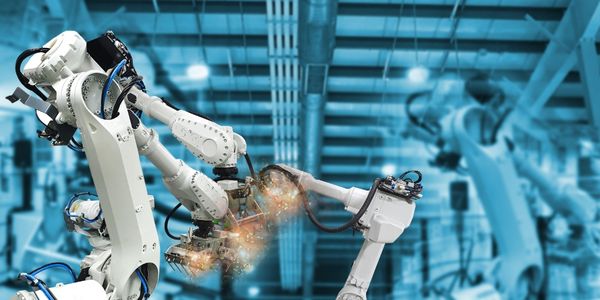Accelerating Nanofluidics Research with IoT: A Case Study at the University of Kansas
Technology Category
- Analytics & Modeling - Digital Twin / Simulation
- Robots - Parallel Robots
Applicable Industries
- Equipment & Machinery
- Life Sciences
Applicable Functions
- Procurement
- Product Research & Development
Use Cases
- Digital Twin
- Virtual Reality
About The Customer
The customer in this case study is Eric Lee, a graduate student at the University of Kansas. His research focuses on nanofluidics, specifically nanowetting problems. Nanofluidics is the study of nanoflows in and around nanosized objects, and is the basis for miniaturization of microfluidic devices down to the nanoscale. Eric uses molecular dynamics codes, such as LAMMPS, for his computational analyses. His work requires him to run multiple analyses quickly and efficiently, necessitating access to a large computing cluster that can work seamlessly with LAMMPS.
The Challenge
Eric Lee, a graduate student at the University of Kansas, was conducting research on nanofluidics, specifically nanowetting problems. His work involved the use of molecular dynamics codes, such as LAMMPS (Large-scale Atomic/Molecular Massively Parallel Simulator), for computational analyses. However, to fully leverage the scalability of LAMMPS and expedite his analyses, he required access to a large computing cluster that could work seamlessly with LAMMPS. He also needed a platform that could support his specific version of LAMMPS and any custom scripts he wanted to upload. The challenge was to find a solution that could provide the necessary computational power and software compatibility, while also being user-friendly and responsive to his specific needs.
The Solution
The solution came in the form of Rescale, a platform that supports LAMMPS and many other software codes across domains. Rescale's hardware was state-of-the-art, promising faster run times for LAMMPS jobs. Initially, Rescale did not include some custom LAMMPS packages necessary for Eric's work, but their engineers quickly resolved this issue. The platform also provided quick and helpful customer support, responding to Eric's queries within a few hours and providing useful screenshots to guide him in setting up his LAMMPS job. The process to run a job on Rescale was simple and straightforward, involving setting up a simulation name, choosing the number of cores needed, uploading the input file and associated data files, choosing the analysis type, and submitting the job.
Operational Impact
Quantitative Benefit

Case Study missing?
Start adding your own!
Register with your work email and create a new case study profile for your business.
Related Case Studies.

Case Study
Smart Water Filtration Systems
Before working with Ayla Networks, Ozner was already using cloud connectivity to identify and solve water-filtration system malfunctions as well as to monitor filter cartridges for replacements.But, in June 2015, Ozner executives talked with Ayla about how the company might further improve its water systems with IoT technology. They liked what they heard from Ayla, but the executives needed to be sure that Ayla’s Agile IoT Platform provided the security and reliability Ozner required.

Case Study
IoT enabled Fleet Management with MindSphere
In view of growing competition, Gämmerler had a strong need to remain competitive via process optimization, reliability and gentle handling of printed products, even at highest press speeds. In addition, a digitalization initiative also included developing a key differentiation via data-driven services offers.

Case Study
Predictive Maintenance for Industrial Chillers
For global leaders in the industrial chiller manufacturing, reliability of the entire production process is of the utmost importance. Chillers are refrigeration systems that produce ice water to provide cooling for a process or industrial application. One of those leaders sought a way to respond to asset performance issues, even before they occur. The intelligence to guarantee maximum reliability of cooling devices is embedded (pre-alarming). A pre-alarming phase means that the cooling device still works, but symptoms may appear, telling manufacturers that a failure is likely to occur in the near future. Chillers who are not internet connected at that moment, provide little insight in this pre-alarming phase.

Case Study
Premium Appliance Producer Innovates with Internet of Everything
Sub-Zero faced the largest product launch in the company’s history:It wanted to launch 60 new products as scheduled while simultaneously opening a new “greenfield” production facility, yet still adhering to stringent quality requirements and manage issues from new supply-chain partners. A the same time, it wanted to increase staff productivity time and collaboration while reducing travel and costs.

Case Study
Integration of PLC with IoT for Bosch Rexroth
The application arises from the need to monitor and anticipate the problems of one or more machines managed by a PLC. These problems, often resulting from the accumulation over time of small discrepancies, require, when they occur, ex post technical operations maintenance.

Case Study
Robot Saves Money and Time for US Custom Molding Company
Injection Technology (Itech) is a custom molder for a variety of clients that require precision plastic parts for such products as electric meter covers, dental appliance cases and spools. With 95 employees operating 23 molding machines in a 30,000 square foot plant, Itech wanted to reduce man hours and increase efficiency.


